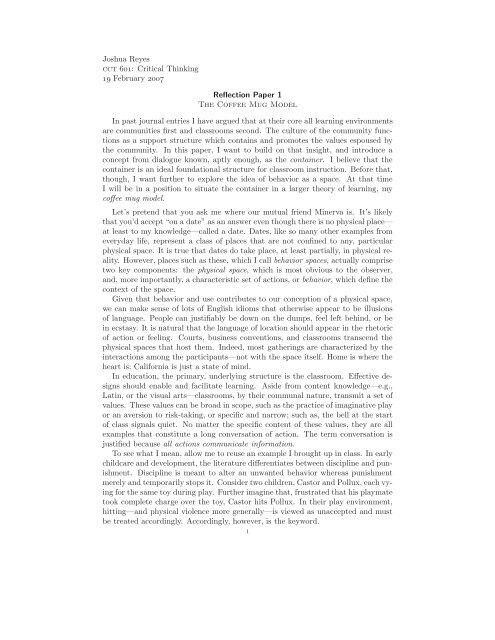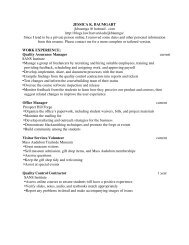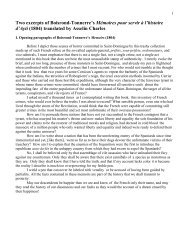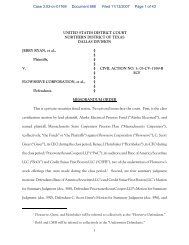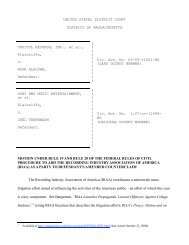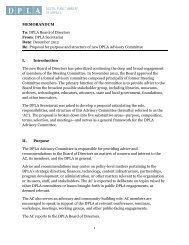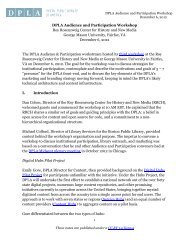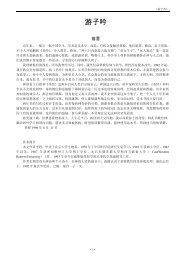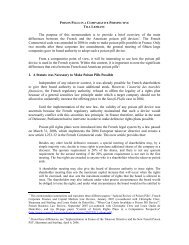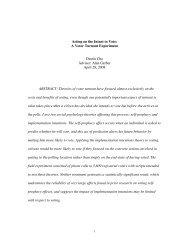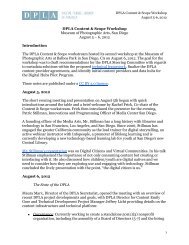Reflection Paper 1
Reflection Paper 1
Reflection Paper 1
You also want an ePaper? Increase the reach of your titles
YUMPU automatically turns print PDFs into web optimized ePapers that Google loves.
Joshua Reyes<br />
cct 601: Critical Thinking<br />
19 February 2007<br />
<strong>Reflection</strong> <strong>Paper</strong> 1<br />
The Coffee Mug Model<br />
In past journal entries I have argued that at their core all learning environments<br />
are communities first and classrooms second. The culture of the community functions<br />
as a support structure which contains and promotes the values espoused by<br />
the community. In this paper, I want to build on that insight, and introduce a<br />
concept from dialogue known, aptly enough, as the container. I believe that the<br />
container is an ideal foundational structure for classroom instruction. Before that,<br />
though, I want further to explore the idea of behavior as a space. At that time<br />
I will be in a position to situate the container in a larger theory of learning, my<br />
coffee mug model.<br />
Let’s pretend that you ask me where our mutual friend Minerva is. It’s likely<br />
that you’d accept “on a date” as an answer even though there is no physical place—<br />
at least to my knowledge—called a date. Dates, like so many other examples from<br />
everyday life, represent a class of places that are not confined to any, particular<br />
physical space. It is true that dates do take place, at least partially, in physical reality.<br />
However, places such as these, which I call behavior spaces, actually comprise<br />
two key components: the physical space, which is most obvious to the observer,<br />
and, more importantly, a characteristic set of actions, or behavior, which define the<br />
context of the space.<br />
Given that behavior and use contributes to our conception of a physical space,<br />
we can make sense of lots of English idioms that otherwise appear to be illusions<br />
of language. People can justifiably be down on the dumps, feel left behind, or be<br />
in ecstasy. It is natural that the language of location should appear in the rhetoric<br />
of action or feeling. Courts, business conventions, and classrooms transcend the<br />
physical spaces that host them. Indeed, most gatherings are characterized by the<br />
interactions among the participants—not with the space itself. Home is where the<br />
heart is; California is just a state of mind.<br />
In education, the primary, underlying structure is the classroom. Effective designs<br />
should enable and facilitate learning. Aside from content knowledge—e.g.,<br />
Latin, or the visual arts—classrooms, by their communal nature, transmit a set of<br />
values. These values can be broad in scope, such as the practice of imaginative play<br />
or an aversion to risk-taking, or specific and narrow; such as, the bell at the start<br />
of class signals quiet. No matter the specific content of these values, they are all<br />
examples that constitute a long conversation of action. The term conversation is<br />
justified because all actions communicate information.<br />
To see what I mean, allow me to reuse an example I brought up in class. In early<br />
childcare and development, the literature differentiates between discipline and punishment.<br />
Discipline is meant to alter an unwanted behavior whereas punishment<br />
merely and temporarily stops it. Consider two children, Castor and Pollux, each vying<br />
for the same toy during play. Further imagine that, frustrated that his playmate<br />
took complete charge over the toy, Castor hits Pollux. In their play environment,<br />
hitting—and physical violence more generally—is viewed as unaccepted and must<br />
be treated accordingly. Accordingly, however, is the keyword.<br />
1
2<br />
In an environment which approaches the situation using punishment, a figure of<br />
authority will at the very least intervene, and save Pollux from immediate, continued<br />
strikes. Castor’s punishment may also include one or more retributive strikes à<br />
la Hammurabi or a forced though undirected time out for reflection. However, if we<br />
wish to keep the distinction between discipline sharp, the punishment, whatever it<br />
may be, should not include practices that encourage self-reflection or other forms<br />
of learning, such as an undirected and unsupervised time-out.<br />
Discipline, by contrast, targets behavior modification. True to its Latin roots,<br />
discipline is a form of chastisement that aims to teach—to offer something for its<br />
recipient to “take away.” Some early childhood theorists therefore suggest focusing<br />
on the victim. In our story, our authority figure would turn to Pollux and ask him<br />
how being hit makes him feel. The response is meant to impart empathy to his<br />
aggressor. We can take the discipline further by having Castor fetch and present ice<br />
or other emollience to Pollux. Through these actions, the authority figure conveys<br />
a lesson: hitting is not an acceptable substitute for verbal communication because<br />
of the precise way it makes others feel 1 .<br />
The distinction between halting punishment and instructive discipline is not<br />
nearly so neat. Both methods recognize a grammar of actions; the difference,<br />
then, is that the tenets of discipline do so explicitly. Actions and reactions form a<br />
conversation, of which verbal communication is only a part. It has been said that<br />
as much as 90% of communication is non-verbal. Body language and the like aside,<br />
situational context and cultural mores mandate proper forms of behavior. To wit,<br />
punishment teaches every bit as much as discipline. What it teaches, however, is<br />
different. Let’s reevaluate the sequence of events:<br />
Context Castor and Pollux want and reach for the same toy; Pollux gets there first.<br />
Castor is frustrated by his unsuccessful attempt to satisfy his internal desires.<br />
Action To communicate his feelings to himself and others, Castor repeatedly hits<br />
Pollux.<br />
Reaction An authority figure, say a teacher, intervenes and answers Castor’s hitting<br />
with physical restraint in order to stop his hitting Pollux.<br />
Subsequent instances of the action-reaction conversation above demonstrate to<br />
Castor that hitting receives attention from an authority figure. The conversation<br />
may not directly resolve Castor’s problem, and it’s likely that he knows the consequences<br />
if he continues his behavior. But that’s precisely the point: Castor will<br />
come to understand the conversation of hitting. He will be able to use the hitting<br />
dialogue as a piece in larger and more complicated conversations of action in exactly<br />
the same way that I use words and small phrases to convey a complex argument.<br />
Instead of addressing the real problem, a matter of communication, punishment<br />
simply engages in a less than useful conversation.<br />
As educators, and more as members of society, we should actively consider which<br />
sort of behaviors we want to use to structure our conversations. These behaviors<br />
will reflect a choice in values. I believe that the single most important classroom<br />
value is respect. In this (and most situations), respect is the willingness to learn<br />
from another. Usually the other mentioned in the definition is another person,<br />
though it need not be. It makes sense to extend the definition to include other living<br />
creatures, institutions (like law), or other fully abstracted concepts (like roles within<br />
1 Certainly there are other ways to handle the situation.
an institution). Respecting one’s feelings, then, means to learn from them. This<br />
is a pretty demanding definition, as it presumes many other components normally<br />
associated with respect and more. In this framework it is not enough to acknowledge<br />
or even tolerate conflicting viewpoints. This definition requires an openness that<br />
assumes learning. That is not to say that learning necessitates adoption, or even<br />
acceptance, of conflicting points of view. Pollux can learn from Castor why someone<br />
might hit another person when he is frustrated. He can then use that insight to<br />
inform his approach to different situations later on. I am by no means suggesting<br />
that Pollux mimic Castor’s behavior.<br />
Respect forms part of the basic container of the classroom behavior space. It<br />
is useful to include of actions such as critical awareness of personal assumptions.<br />
Additionally, we might value explaining one’s reasoning—which helps to expose<br />
personal assumptions. There are more, but the point of this paper is not give<br />
explicit directives for effective classroom design. Instead, I want to describe the<br />
general form for a class effective classroom designs will take. I call the following,<br />
general form the Coffee Mug Model of learning.<br />
In this model, a coffee mug represents each participant in the learning community—<br />
including the teacher. To start, each mug is almost entirely full. The contents<br />
signify the pre-existing knowledge, cultural biases, superstitions, and the like, that<br />
individuals bring with them to the classroom. The container itself is a behavior<br />
space. As such it structures the presentation of the contents and mediates what<br />
each individual can and cannot accept. Here we realize how crucially values interact<br />
with input sensory data. On its own, any single datum is without meaning until it<br />
has been accepted and processed within the container.<br />
The mug representation of student esteems the knowledge that students have<br />
themselves. It respects their values (both in my and the general sense of the word).<br />
It creates a setting which encourages mutual teaching and learning. In short, it<br />
exploits the community structure in to build a student-centered learning environment.<br />
Once in the classroom, students share their information through any diverse<br />
forms, metaphorically pouring out. On the one side, this process makes room for<br />
new ideas. At the same time, it provides an effective data collection strategy.<br />
This model exploits any asymmetry of ignorance within the group. Participants<br />
bring together potentially non-overlapping points of view supported by their experiences,<br />
and then present them to the group. As active learners, members need<br />
only to listen to each other, compare, and synthesize the information offered before<br />
them. Sense-making is done both during private reflection and in public sharings.<br />
The instructor guides the discussion to make sure that it is content-relevant, thus<br />
ensuring that the learning environment is necessarily knowledge-centered.<br />
Because participants constantly expose their thinking, instructors gain a better<br />
sense of what each member of the community understands than is possible through<br />
3
4<br />
isolated, conventional assessment methods. The classroom itself is a continuous, living<br />
formative assessment. Perpetual acquisition of knowledge, understanding, and<br />
skill and revision thereof appear as natural side-effects of the coffee mug model.<br />
Behaviors generally thought to be useful for learners, such as intrinsic motivation,<br />
curiosity, and risk-taking, show themselves in the coffee mug model members because<br />
the structure allows and encourages them.<br />
To put the model in practice is not a simple feat. Cultural change do not occur<br />
overnight. 2 Its approach relies on developing a culture within a community of perhaps<br />
very dissimilar points of view. I predict that instilling sustained, unanimous,<br />
pair-wise respect—which is the most vital part—will also be the hardest part to<br />
achieve. I have not given any express suggestions that would lead to an immediate<br />
implementation of my model. This is, in part, because each community, like<br />
each student, already carries with it a culture. To ignore the community-centered<br />
component of classroom design, even to replace it with another community base,<br />
is irresponsible. The coffee mug model should build on top of existing culture, not<br />
displace it. Over time, it is my hope that the coffee mug model will sink deep<br />
into the existing culture until the two are no longer distinguishable. At that time,<br />
learning will really have made it out of the physical classroom into everyday life.<br />
And as we have seen before, everyday life is nothing more than another behavior<br />
space. We might as well make it a classroom.<br />
2 Most cultural changes take place over a long period of time because of the time constraints<br />
imposed on culture by tradition. Cf. Entry 2.


